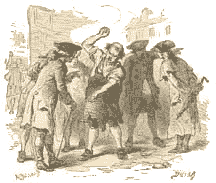The French and Indian War had been an expensive undertaking for Britain. The national debt had doubled and the cost of military protection for the North American colonies had soared. Not unreasonably, the British were inclined to asked the American colonies to contribute money. George Grenville, the Whig Prime Minister, floated the idea of a stamp tax to pay some of these expenses.
The plan was not well received in the colonies. In Connecticut, the Assembly requested Governor Thomas Fitch to put together a list of objections to the plan. This he did, but his document, while critical of the proposed tax, conceded the right of Britain to apply some kind of tax to raise revenue for its colonial expenses.
In Connecticut, patriots were incensed that he had conceded so much, and Fitch was defeated for re-election in 1766. On the other side of the Atlantic, the British were incensed that he had complained at all. The situation was reminiscent of Benjamin Franklin's position when he put forward the Albany Plan of Union at the Albany Congress in 1754.
Parliament passed the Stamp Act in March 1765. The law was to become effective in the colonies on November 1 and was announced by Prime Minister George Grenville many months in advance; he expressed a willingness to substitute another revenue-raising measure if a more palatable one could be found.
The act required the use of stamped paper* for legal documents, diplomas, almanacs, broadsides, newspapers and playing cards. The presence of the stamp on these items was to be proof that the tax had been paid. Funds accumulated from this tax were to be earmarked solely for the support of British soldiers protecting the American colonies. Violators of the law were to be tried in the vice admiralty courts, a detail that would not be overlooked by its critics.
The British authorities were not trying to oppress the colonists and regarded the stamp tax as entirely reasonable; even Benjamin Franklin, then a colonial agent in London, gave his grudging acquiescence to the plan.
 Despite parliamentary intentions, colonial reaction was adverse and immediate. The Sugar Act of the previous year had been a tax on trade, in effect an indirect and external tax. But in the Stamp Tax the Americans for the first time were faced with a direct, internal tax. This distinction was argued effectively in the writings of John Dickinson, one of the early leaders of the opposition to British policies. However, these arguments seemed to be incomprehensible hair-splitting to Parliament and royal officials.
Despite parliamentary intentions, colonial reaction was adverse and immediate. The Sugar Act of the previous year had been a tax on trade, in effect an indirect and external tax. But in the Stamp Tax the Americans for the first time were faced with a direct, internal tax. This distinction was argued effectively in the writings of John Dickinson, one of the early leaders of the opposition to British policies. However, these arguments seemed to be incomprehensible hair-splitting to Parliament and royal officials.
The effects of the Stamp Act were to unite some of the most powerful elements of colonial society — lawyers, clergymen, journalists and businessmen. Opposition came in a variety of forms. Some was reasoned and informal, such as James Otis’ The Rights of the British Colonies Asserted and Proved, a pamphlet that proclaimed the unconstitutionality of taxation by agencies in which the colonies were not represented. John Adams wrote a series of resolutions protesting the act for the town of Braintree, Massachusetts, and other Massachusetts towns took similar actions.
A more formal response came in the meeting of the Stamp Act Congress in October 1765, an inter-colonial effort to orchestrate opposition to the British plan.
The greatest impact, however, came through the Stamp Act riots in which violence was used to intimidate potential tax agents and public demonstrations were employed to solidify radical opposition. Shopkeepers agreed among themselves not to sell British manufactures (Nonimportation Agreements) and strong-arm Sons of Liberty made certain that the merchants maintained their resolve.
The general unpopularity of the Grenville program led to the failure of his government in June 1765; the Marquis of Rockingham replaced him and began the process of finding a way out of the chaos. After much debate in Parliament, the Stamp Act was repealed on March 17, 1766 due in no small part to the protests of merchants at home who felt the pinch of the nonimportation programs. The Stamp Act was repealed out of expediency, not because American arguments about taxation had been accepted in England.
As a face-savings gesture, however, Parliament approved the Declaratory Act (March 1766), which stated in part that Parliament:
had, hath, and of right ought to have, full power and authority to make laws and statutes of sufficient force and validity to bind the colonies and people of America, subjects of the crown of Great Britain, in all cases whatsoever.This statement of Parliamentary supremacy was wisely ignored by colonial opposition leaders, who were contented with their victory over the Stamp Act.